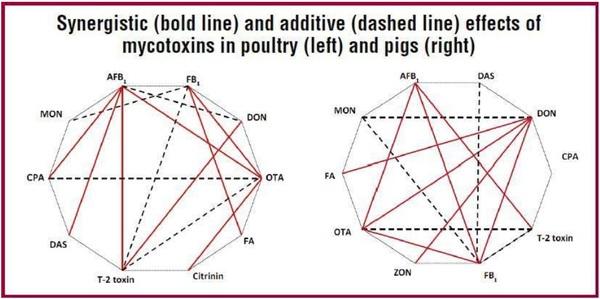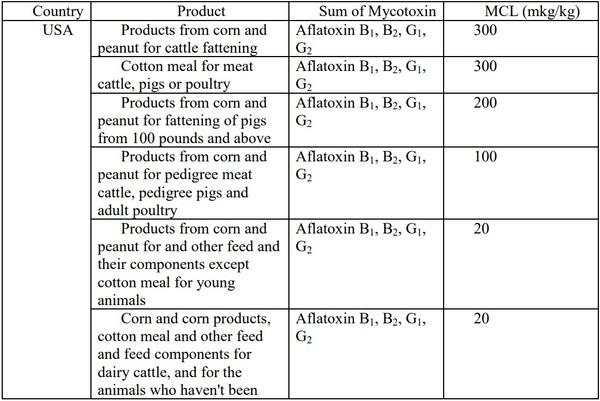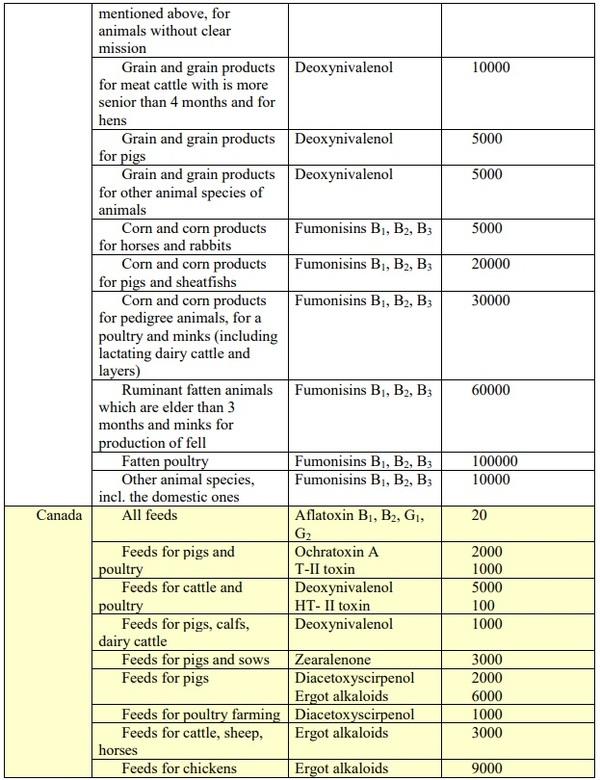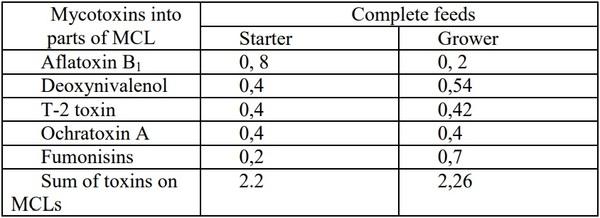In scientific publications in the 1980s – 1990s you can find information about a spreading of mycotoxins. But since that time cultivars and agricultural technology have changed, methods of grain storage and grain processing have improved due to the overal progress. Between January 2009 and December 2011 Austrian researchers selected 7049 samples of grain on different continents. The samples were analyzed for the occurrence of aflatoxins (AFB), zearalenone (ZEN), deoxynivalenol (DON), fumonisins (FUM) and ochratoxin A (OTA) by all modern methods. Researchers have performed 23,781 mycotoxin analyzes in all. AFB, ZEN, DON, FUM and OTA were present respectively in 33%, 45%, 59% 64% and 28% of analyzed samples. Thereby, grain and feed in the word are more frequent contaminated with deoxynivalenol and fumonisin. From the 7049 samples, only 19% of them tested negative for the presence of the five analyzed mycotoxins (but it doesn’t rule out the possibility of presence of other mycotoxins). 33% of samples showed the presence of one of the five mycotoxins, and two or more of the tested mycotoxins were present in 48% of the commodities.
In America, analysis showed that 10% of finished feed tested below the limit of detection for all analyzed mycotoxins. 50% tested positive for the presence of one mycotoxin, and in 40% of the samples, two or more mycotoxins were present. In Europe, 39% of the finished feed samples analyzed tested positive for 2 or more mycotoxins, 37% tested positive for one mycotoxin. In Asia, 82% of finished feed were contaminated with two or more toxins, 12% - with one, and only 6% of feed tested below the limit of detection for mycotoxins. (Rodrigues I. and Naehrer K. 2012).
According the results of these studies, more than 76% of feed are affected by mycotoxins. In America and in Europe, 39 - 40% of feed contained several mycotoxins. In Asia its parts increased to 82%. It results from this that polymycotoxicosis pose a real threat.
The microscopic fungus called mould or mould fungus are part of an ecosystem. They are widespread in the nature. The grain raw materials are often contaminated by several mycotoxins. The first stage of infection of grain (and roughage) occurs in the field by so-called field fungus. Field fungus is mainly different types of the genus Fusarium.
As a result the grain harvested from a field contains various amounts of trichothecene mycotoxins and other ones to a lesser extent. Field fungus dies off after grain drying and transfer in storage. But the mycotoxins formed before don't disappear. Storage mould or storage fungus goes on change by field fungus. As a result grain will contain some tens of mycotoxins. Their concentration can be as extremely low (at the level of the minimal threshold of detection), as so high that it’s capable to cause poisonings and even death of animals. Therefore it is correctly to speak only about doses of mycotoxins in raw materials, not about raw materials free from mycotoxins.
In this connection, veterinary and human medicine experts defined relatively harmless doses for the most studied toxins. The maximum doses which don't cause negative changes call "maximum residue limits" (MRL) of toxin in raw materials or in feed. In Russia, expression "maximum concentration limit"(MCL) is more habitual. In world practice MRL is often expressed in ppb or ppm that is equivalent mkg or mg per 1 kg. Individual MCL exist for each toxin: Aflatoxin B1- 0,02; Ochratoxin A - 0,05; Sterigmatotsistin - 0,1; T-2 Toxin - 0,1; Deoxynivalenol (Vomitoxin) - 2,0; Zearalenone - 2,0 mg in 1 kg of a feed. MCL depends on an age, a physiological condition and kind of animal. The pigs are the most sensitive to mycotoxins among animals. The cows are less and the poultry are least of all. Moreover, if several mycotoxins are detected in feed it is necessary to consider interaction of mycotoxins on an organism during the course of a metabolism. Comprehensive recent review on this question was published in Feedstuffs in 2011.

Bellow you can find the official data on the countries of North America:
These data are given just for comparison and they shouldn't be transferred to the Russian reality. There are features of the national legislation, specifics of diet structure and quality of raw materials. All of this has essential influence on maximum concentration limit (MCL).
MCL is defined by research: scientists add only one studied mycotoxin (with purity of a preparation 95 - 99%) to feed which initially doesn’t contain mycotoxins. Schematically process looks as follows: several groups of animals are fed by complete feed with increasing concentration of mycotoxin. Then scientists reveal the group of animals in whom the maximum dose of the added toxin didn't cause registered changes. The content of toxin in a feed of this group takes as MCL (maximum concentration limit). If animals consume a feed with the content of toxin below maximum concentration limit, mycotoxin is subjected to transformations by system of a metabolism of xenobiotics (foreign substances for an organism) like drugs, antibiotics, synthetic antioxidants, colouring agent and some other substances (Park D., 1985; Sheweita S. A., 2000; Galtier P. et al., 2008).
The system of protection against foreign substances inactivates different foreign substances with a various speed. At the first stage foreign (toxic) substance is oxidized with accession of hydroxyl group and becomes water-soluble. Toxicity of initial substance decreases at this stage. The formed metabolite can be excreted through kidneys or the reactions of conjugation can occur. As a result the substance loses toxicity and it’s easily excreted with urine. The endogenous detoxication (metabolism) of various mycotoxins proceeds with an unequal speed and it is various at different types of animals for the same toxin (Adav S.S. Govindwar S.P. 1997). Various MCL for separate mycotoxins are partly defined by this occurrence. It is important to know that this system has limited opportunities on a detoxication which influence MCL.
As it was told earlier MCL (maximum concentration limits) is defined in the conditions of using only one pure mycotoxin. But in natural conditions mycotoxicosis caused by one mycotoxin can’t exist – as a fact polymycotoxicosis are found more frequent. In actual practice laboratories define separate concrete mycotoxins. However, it is necessary to pay attention that formation of mycotoxins presents multistage process in fungus cells. Synthesis products at penultimate stages (pretoxins) possess toxicity too but this one is weaker. Therefore if mycotoxin in the feed is detected at the level of MCL than its negative effect will be stronger because of additional influence of its pretoxins. Characteristic of the last aren't well studied. They aren’t defined in laboratories.
At the same time mycotoxins and pretoxins will be inactivated by the same system of protection of an organism from foreign substances, they’ll create additional load on it.
So how consider influence on animals by polymycotoxicosis if sizes of MCL for different substances differ a lot?
Let's take a look at the following example. Several mycotoxins were revealed in complete feed for broilers. Concentration mycotoxins didn't exceed MCL (table 1).
Results of the analysis of complete feed on the content of mycotoxins:
Concentration of each separate mycotoxin didn't exceed the fixed sizes MCL according to existing regulatory documents and, therefore, it is possible to make conclusion that a feed is quite safe. However, according to the fact that mycotoxins are inactivated in an organism by one system of a metabolism of xenobiotics, load of this system will increase because of presence of several mycotoxins in feed.
Drugs especially antibiotics will increase load. And ability of system to an inactivation of separate mycotoxins (and drugs) will decrease. So how to estimate influence of such feed on animals? The sums of mycotoxins in a starter are 1,464 mg/kg and in a grower are 4,091 mg/kg. They are strongly separated. The increase in the sum of mycotoxins in the feed is caused by increasing fumonisin on 2,5 mg/kg or by 3,5 times, but it was still lower than MCL. At the same time if concentration of T-2 toxin or other mycotoxin with low MCL increased even on 0,5 mg/kg, the feed wouldn’t be suitable for feeding. Therefore summation of weight amounts of mycotoxins in a feed doesn't give the grounds for its objective assessment. Let us accept the MСLs for a One unit operates independently of the mass values of this quantity for each mycotoxin and then content weight values of mycotoxins in the same feeds into parts of MCL (table 2)
The content of mycotoxins in the complete feed, expressed in parts of MCL:
According to calculations given in the table we can make conclusion that toxicity of feeds on the sum of parts of MCL was identical and exceeded unit. In research of pure mycotoxins (80 years of last century) it was established that they mutually strengthen influence of each other at joint presence at the feed (Adav S.S. Govindwar S.P. 1997; Ramsdell H. S. and Eaton D. L. 1990) and total negative effect will be higher, than sum of content of mycotoxins in parts of MCL. It has quite available explanation from the point of view of biochemistry of transformation of mycotoxins in an organism. In practice in feed, except revealed mycotoxins, there are always incomplete products of their synthesis (pretoxins) which also create load of system of an endogenous detoxication. They strengthen negative influence on animals but their effect can't be quantitatively considered.
It is necessary to note that Russian laboratory defines 5 mycotoxins whereas France one can define 42 mycotoxins. And all of them are present at feed - the question is only about their dose. But the sum of 5 mycotoxins (even most widespread) will be always lower than the sum of 42 mycotoxins. Moreover, the list from 42 found mycotoxins isn't exhaustive: it only testifies technical capabilities of laboratory at present.
In conclusion, we want to note that the assessment of feeds or feed raw materials on separately taken mycotoxins doesn't give a full picture for an assessment of potential danger. It’s necessary to summarize parts of MCL on each mycotoxin found in a feed. The negative effect of mycotoxins revealed by scientific research of MCL during estimation, will be always lower, than the same sum of mycotoxins of a natural origin.












